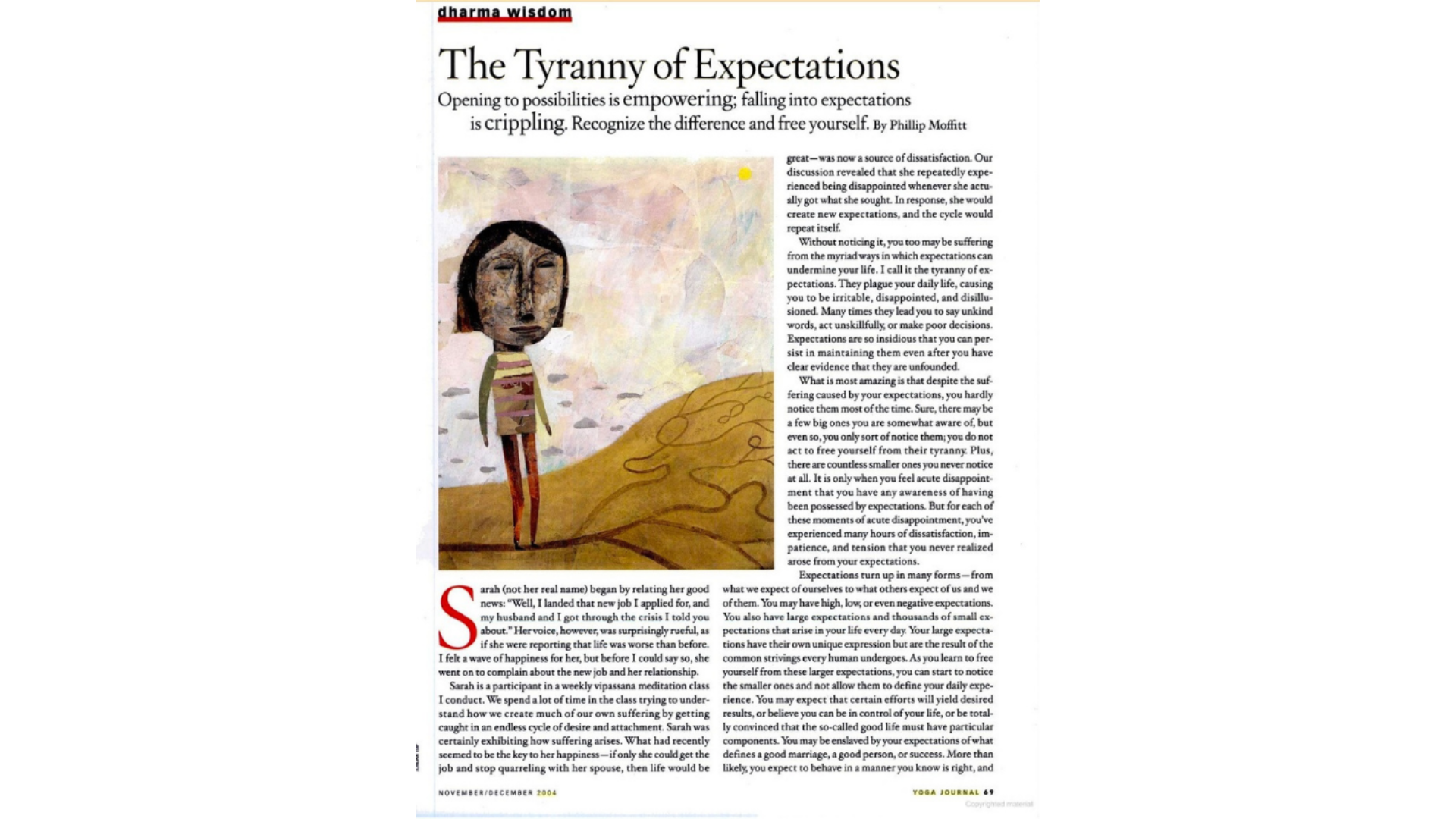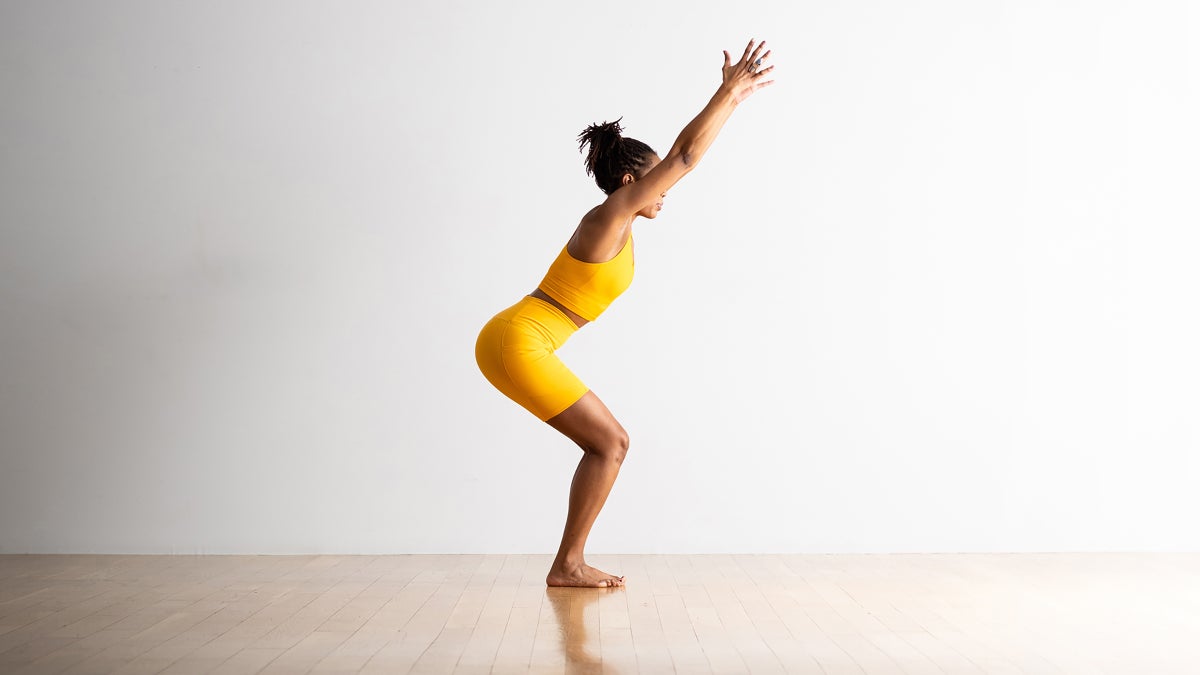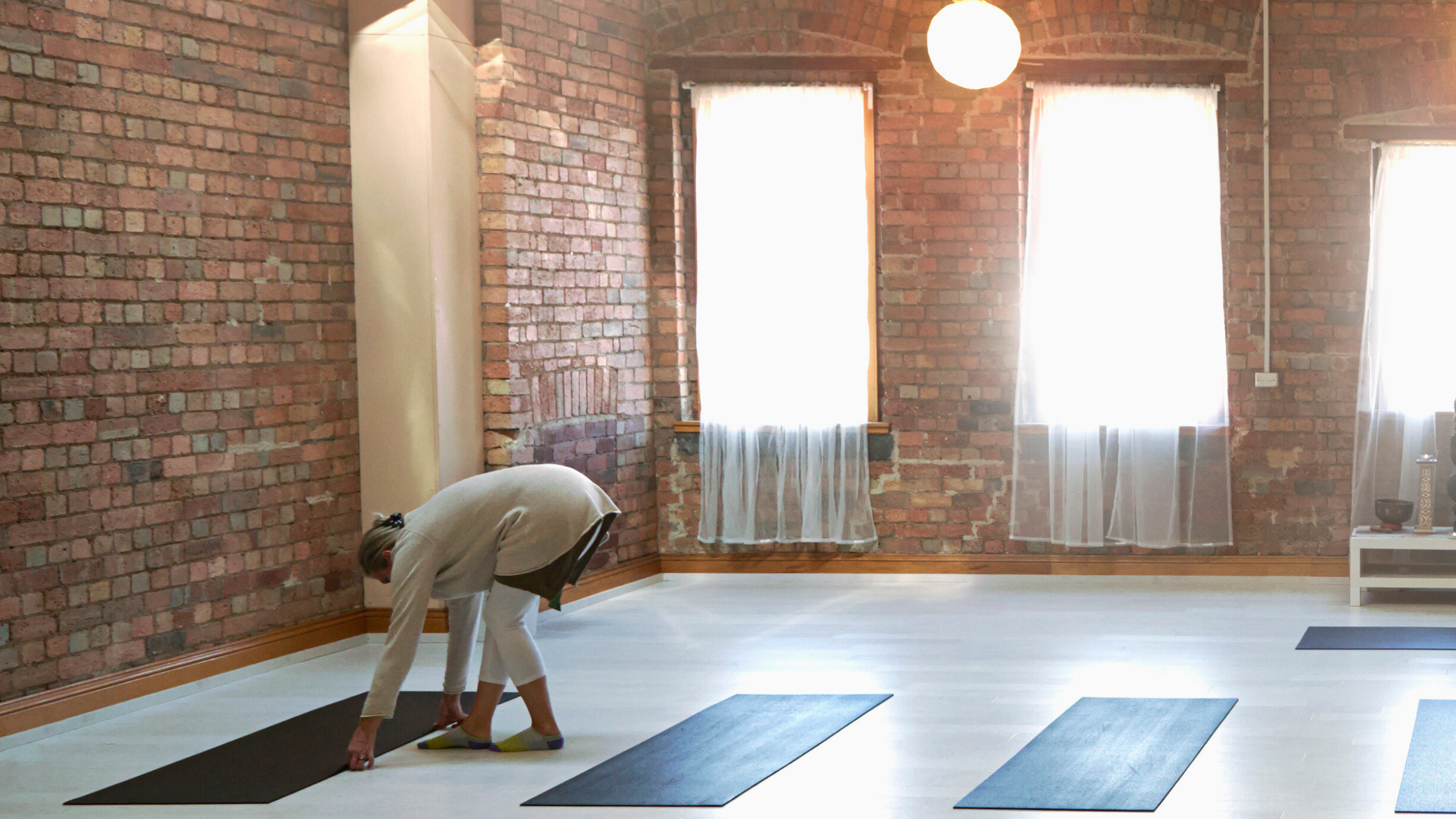Updated October 21, 2025 08:32AM
Yoga Journal has been sharing instruction, wisdom, and personal experiences related to the physical and spiritual practice of yoga for the last 50 years. Interviews with PBS teacher Lilias Folan and spiritual leader Ram Das. Regular contributions by the “father of modern yoga,” B.K.S. Iyengar. Poetry. Regular columns dedicated to poses as well as reviews of books and VHS (VHS!). Musings as to why the heck we exist. And we have to say, in the 1970s and ’80s, there was quite a lot of content on tantra.
Most of these articles appeared in the 300-plus print issues of Yoga Journal that launched in 1975. Many appear as exclusively digital content. Although the topics Yoga Journal has and continues to explore are diverse, the intention has always been the same—a desire to share yoga. And underlying it all was always a curiosity as to how this practice relates to everyday life.
The following list is a sample of the thought-provoking content YJ has created. Each article stands out as expressive of this thing we call yoga. It’s with appreciation to all the contributors and editors over the years, as well as to our readers who return for information and entrust us with your practice, that we share these insights.
25 of the Most Thought-Provoking YJ Articles
The following articles continue to draw our attention and expand our awareness years—and, in many instances, decades—after being written.
1. Seeing What Is…And Going Beyond It
Elmer Brunsman, Jr. | July 1975
Appearing in one of the earliest issues of YJ, this article explores the well-known yet somewhat enigmatic J. Krishnamurti, an Indian spiritual leader who held the belief that the search for what he called “Ultimate Reality” has “nothing to do with priests, churches, dogmas, or organized beliefs.” It’s an elucidating read that brings context to a name and a man that’s mentioned fairly commonly yet not often explained. The article’s examination of what it means to pursue meaning in life—and whether it looks differently than many in the yoga space profess—continues to linger in our thoughts.
2. Why Is the West Interested in Yoga?
B.K.S. Iyengar | July/August 1977 issue
There is a considerable amount of pondering about the “why” of it all in the initial issues of Yoga Journal. Why yoga? Why now? This short essay from Iyengar offers a distillation of the West’s fascination with yoga as witnessed from an Eastern perspective. For Iyengar, the West’s obsession with materialism and technological progress will never replace inner peace and spiritual evolution, hence our ever-increasing interest in yoga borne of an innate spiritual void. This sentiment hits hard. It also rings as true today as it likely did in 1977.
3. A Conversation With Lilias Folan
Deena Brown | July/August 1979
If ever there were an underappreciated yoga influencer, it’s Lilias Folan. The teacher and mom started leading classes at a local YMCA in Cincinnati, Ohio, and eventually went on to teach millions through her PBS TV series, Lilias, Yoga and You. Yet every interview with her reveals someone who was less concerned with her number of followers and more focused on her message. In this conversation, her modest sense of self comes through as she explores mysticism, expectations, disappointment, and a very pragmatic approach to an examined life. Reading her words makes us curious about what insights she might share if she was still teaching today.
4. Intimacy as Spiritual Voyage
Carol Cavanaugh | March/April 1981
Written at a time when psychology talk was increasingly common in pop culture, this exploration of relationships might read as reductive. But take a closer look and you’ll realize that it explores essential and commonly overlooked aspects of relationships, including the awareness of the effect our vibes have on one another and the tendency to conflate relationship with romance.
5. Women’s Spirituality
Catherine Maclay | March/April 1983
This exploration of all things goddess-related reminds us that the emphasis on connecting with the goddess within predates the recent clamoring of social media trends and involves much more feminist politics than contemporary society may recall. The interview with researcher and author Charlene Spretnak explains how her work began when she was reading myths to her daughter and found mostly male-dominated tales and explores the distinctions between female-oriented religions and their existence tens of thousands of years before patriarchal and hierarchical religions.
6. The Great Chakra Controversy
Dio Urmilla Neff | November/December 1985
How many chakras are there? Where exactly are they located? If you’ve spent much time practicing or teaching yoga, you may think you know the answers. Yet there is considerable lack of accord as to the number, location, and specific function of the chakras. This article begins to untangle a complex and nuanced conversation and challenges the reader to question what they presume to know as true, which, fittingly, is exactly what yoga asks us to do at large in life.
7. How to Practice Warrior III Pose (Virabhadrasana III)
Judith Hanson Lasater | January/February 1986
“Insightful” is just one of the ways we’d describe this lesson on coming into Warrior III from Yoga Journal’s most well-known co-founder. Take in the cues and the tie-ins to everyday life. Hanson Lasater wants you to understand how much more there is to yoga than the postures—and Yoga Journal has attempted to educate students and teachers alike about that fact since its first issue.
9. Once Upon a Time
Anne Cushman | July/August 1993
Storytelling is part of the essence of what it is to be human. This article explores the power of story and mythology throughout the ages, helping us learn about and reckon with the world, with the narrative making everything seem a bit more magical. In 1993, Cushman writes about how TV and movies have supplanted oral storytelling. Now, we have social media, which actually helps us accomplish much of what this article suggests: tell your own stories. Tell them to everyone you can.
10. Cyberspirit
Jeffrey Zeleski | April 1996
Writer Zeleski, who went on to become editor of Parabola, mentions that at the time this article was published, there were about 21 yoga websites total. He also explains what a modem is and how to access the World Wide Web. His concern about what he describes as the lack of prana in cyberspace still applies today, although most of us have figured out that you shouldn’t rely on the Internet for all your answers in a spiritual quest. Instead, you take what you find online and use it to help cultivate that prana IRL.
11. If Yoga Is Chic, Does That Mean I Am, Too?
Anne Cushman | September/October 1998
Yoga’s popularity among mainstream American society in the late 90s must have been difficult for hard-core 20th-century yogis to deal with—and you can feel that in this essay. On the one hand, Cushman is excited by yoga’s increased popularity. But she also mentions being disconcerted by the pop-culturization of the practice. Will yoga retain its purity and power now that everyone is doing it? Her concerns were definitely prescient. “There’s a subliminal message contained in these images: that if you do just enough Sun Salutations, you won’t have to grow old and die,” she wrote of yoga’s hyper-shiny depiction in media at the time. She’s not wrong about that messaging.
12. This Which We Call Body
Phillip Moffitt | January/February 2000
Despite how transformative an hour of yoga can feel in the body, the reality is that we’re likely to resume our forward head posture and shrimp-shaped spinal curves the second we’re no longer on the mat. Moffitt acknowledges this reality and encourages the reader to rely on the principles of yoga (i.e., viewing the body and mind as one) to understand how we might incur lasting change off the mat.
13. Disappointment is Hell
Phillip Moffitt | May/June 2000
“Where is the yoga in all this reactiveness?” That’s the perpetual question the writer explores related to the very human experience of feeling “sad, depressed, worried, irritated, moody, anxious, grumpy, lethargic, or nonresponsive” in response to disappointments in everyday life. The answer meanders through Buddhism, the writings of Dante, and foundational teachings of meditation—and it doesn’t disappoint.
14. Come to Your Senses
Shiva Rea | November/December 2004
This is the Yoga Journal equivalent of the longer reads in The New Yorker or The Atlantic. Meaning it’s not something you skim for quick takeaways. It’s intended to be read and contemplated and integrated in its entirety. In it, longtime teacher and YJ contributor Shiva Rea explores and explains the ancient concept of rasa and applies it to contemporary life.

15. The Tyranny of Expectations
Phillip Moffitt | November/December 2004
Most of us are aware that we hold expectations. Yet we’re probably not aware of the nuanced ways in which they infiltrate our everyday existence—and how we fall into an endless loop of wanting and, even when we receive exactly what we were convinced would make life better, being dissatisfied. If we’re not careful, the ensuing drama can become the story we tell ourselves of our entire existence. Moffitt helps you understand how to break the cycle through a yogic lens.
16. Slow Hands
Jonathan Foust | July/August 2005
If you’re someone with an endless and overwhelming to-do list, this article is for you. Foust underscores one of the timeless messages of yoga, which is to sloooow down. And not in a performative way. Foust explains how slowing down can actually help with that aforementioned to-do list and overwhelm and shares a guided meditation exercise (that, yes, includes your hands) to pull your focus into the present moment.
17. Financial Factors to Consider Before Becoming a Yoga Teacher
Jason Crandell | 2007
Much of the early content on Yoga Journal was insightful yet also theoretical. Crandell brought a practical-minded approach to his teaching and his writing, including this very reality-driven exploration of what it means to become a yoga teacher. Although the article was written two decades ago, the advice still applies.
18. Study Up: The Best Yoga Books and Videos
Richard Rosen | 2007
Our understanding of anatomy and accessibility and how they relate to the physical practice of yoga has evolved exponentially in the last two decades. Yet there’s still much to be learned from previous interpretations and ways of teaching yoga. This humorously written yet seriously compiled list of essential books and videos from longtime contributing editor Richard Rosen brings classics as well as easily overlooked treasures to your attention. Expect to be reintroduced to your body, your breath, and your understanding of the practice you know as yoga.
19. The 5 Stages of Detachment: Learning How to Let Go
Sally Kempton | August 2007
The principle of detachment is commonly misinterpreted as showing no emotion or simply “letting go” of anything in life that’s challenging. This article is refreshing precisely because Kempton debunks that myth. By sharing relatable and, at times, heart-wrenching stories from friends’ lives and her own, she defines “hard-won detachment,” or the understanding that detachment isn’t bypassing. It’s moving through emotions and experiences with awareness and coming out with a changed perspective on the other side.
20. Find Your Soul Mate
Helena Echlin | August 2007
The landscape of dating has changed a lot since this article was written, yet it underscores a fundamental truth which reminds us of the Gandhi quote, “Be the change you wish to see in the world.” Except this article’s version would read, “Be the person you want to date in the world.” In the article, Echlin explains that it’s less important to seek a soul mate, spouse, partner, etc., than it is to turn inward, know yourself, and fulfill your own desires. It can be comforting, as a single person, to focus on those aspects of dating that are actually within your control; Echlin, in great detail, describes yoga as one of those aspects.

21. Power Moves
Lindsay Tucker | March/April 2021
There’s much-deserved talk in recent years about cultural appropriation in yoga. Yet there’s also the issue of how the practice supports those of any culture. This profile of Indigenous yoga teacher Shayla Stonechild, who founded the Matriarch Movement, explores how turning to the practice of yoga supported her in helping women—including herself—reclaim their culture, create community, and retell their stories of resilience.
22. Game Changers
Tasha Eichenseher | November/December 2021
This collection of mini profiles falls among the most essential reads Yoga Journal has published. The feature brings overdue recognition to those who have not only made way for conversations around appropriation and inclusivity but who have worked to ensure yoga in America includes “Black and brown and queer” faces, writes the former brand director. “Yoga has changed. And these are the people who’ve changed it,” explains Eichenseher. In other words, these are the game changers.
23. The Future of Yoga
Deanna Michalopoulos | 2022
A thoughtful consideration, through the lens of futurists and foresight strategists, of the many considerations as we consider yoga in the years ahead. Yet rather than becoming lost in tech, the article balances the potential for biofeedback and the metaverse with understanding the origins of yoga and altering our perspective of disabled yoga students. Along the way, Michalopoulos reminds us, in a manner of speaking, of the difference between what’s virtual and what’s real.
24. Can You Be Too Mindful?
Jennifer Chen | January/February 2022
As the article explains, being present and quieting one’s thoughts aren’t always described accurately. “Meditation gets portrayed as a panacea for parenting, happiness, depression, anxiety, overeating, and more,” explains Chen. The article disentangles meditation from mindfulness, shares caveats on the limit of scope for each, and explains that no, they’re not a magic fix, and yes, they can still change your life.
25. I Always Pause and Look at Students’ Feet Before I Teach Yoga. Here’s Why.
MacDuff Perkins | 2022
What began as a casual mention during a conversation with one of our editors turned into the article readers clicked on more than any other in recent years. Perkins, a yoga teacher, takes the reader through her beautifully articulated thoughts and musings about what individual students may need based on the subtle physical and emotional revelations she intuits as everyone stands on their mats before class. The essay is an intermingling of awareness and everyday life, which is quietly emblematic of yoga itself.







